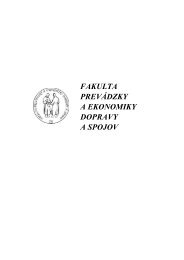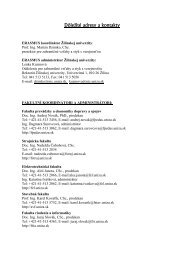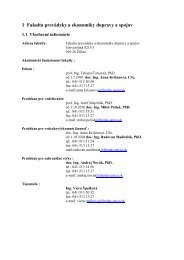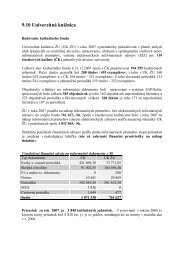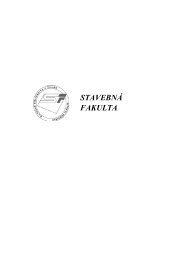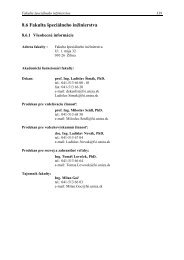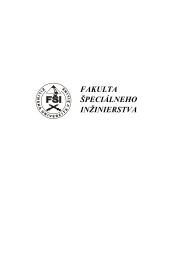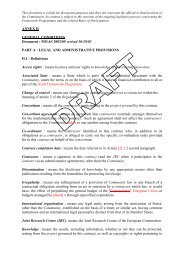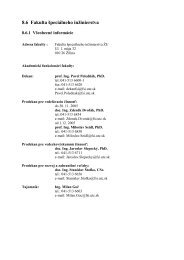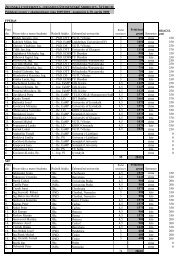posudzovanie vplyvu automobilovej dopravy na - Žilinská univerzita
posudzovanie vplyvu automobilovej dopravy na - Žilinská univerzita
posudzovanie vplyvu automobilovej dopravy na - Žilinská univerzita
Create successful ePaper yourself
Turn your PDF publications into a flip-book with our unique Google optimized e-Paper software.
C O M M U N I C A T I O N S<br />
I S<br />
a<br />
k z Opt 2 b w S 2 k Sx (8)<br />
with k Sx – longitudi<strong>na</strong>l stiffness of secondary suspension.<br />
If the equation (8) is fulfilled, the single-axle running gears<br />
will be radially steered during curving by the forces in the secondary<br />
suspension and in the wheel set coupling.<br />
The coupling of the single-axle running gears increases the<br />
running stability too. The influence of primary suspension and of<br />
running gears coupling was investigated by parameter a<strong>na</strong>lysis on<br />
a half train simulation model (Fig. 9). The a<strong>na</strong>lysis results are represented<br />
with stability contour plots for a residual damping D <br />
0% at a conicity of 0.4 (upper conicity limit for the testing and<br />
acceptance of the vehicle according to UIC-518 for a maximum<br />
speed between 140 and 200 km/h), see Fig. 11. The stability<br />
increases with the gaining of yaw stiffness k z and the lateral stiffness<br />
k y of the running gear coupling. In order to achieve a radially<br />
steering design, the yaw stiffness k z should be in the vicinity of<br />
the value according equation (8), therefore relatively low. Under this<br />
condition the stability can only be increased changing the lateral<br />
coupling stiffness k y . In the primary suspension, a more important<br />
role is played by the longitudi<strong>na</strong>l stiffness k Px of the axle guidance.<br />
The lateral stiffness k Py has a subordi<strong>na</strong>te role.<br />
<br />
Fig. 12 Measured values of steering angle between the wheelsets<br />
of coupled single-axle running gears in comparison with calculated<br />
ideal value<br />
The theoretical a<strong>na</strong>lyses carried out determine the design philosophy<br />
of the coupled single-axle running gears. The stiffness of<br />
the secondary suspension k Sx k Sy , defined by running comfort<br />
properties, can be used for calculating the yaw stiffness k z of the<br />
running gears coupling required in respect to curving according<br />
equation (8). Looking on the coupling of running gears, an increase<br />
of the critical speed can be achieved by increasing the lateral stiffness<br />
of the coupling k y . An increase of the yaw stiffness k z would<br />
improve stability as well, but the value of k z is limited by the<br />
curving properties as already mentioned. The longitudi<strong>na</strong>l axle guidance<br />
and primary stiffness k Px , should be stiff. The lateral axle<br />
guidance and primary stiffness k Py can be relatively soft to reduce<br />
the lateral dy<strong>na</strong>mic forces between wheel and rail.<br />
Prior to series application of the coupled single-axle running<br />
gears FEBA, two prototype running gears were subjected to extensive<br />
tests [11], [12]. The test runs have completely confirmed the<br />
anticipated running characteristics. The capability of the running<br />
gears to steer themselves radially in a curve was judged by measuring<br />
the steering angle (Fig. 12) between the wheel sets of the<br />
coupled running gears. The measurements confirmed almost ideal<br />
radial steering ability in curves with radii between 300 m and<br />
500 m. The slope of the regression line reaches 84% of the ideal<br />
value. Subsequently, the wheel-rail forces are low as described in<br />
[12]. The vehicle type tests in autumn 2000 and summer 2001<br />
demonstrated the fulfilment of the anticipated design results and<br />
the compliance with the limit values.<br />
4. Conclusion<br />
Bogies and running gears with radial steering wheel sets reduce<br />
mainte<strong>na</strong>nce costs caused by wear and track fatigue and meet recommendations<br />
for environment friendly design. To achieve steering<br />
ability of a two-axle bogie, the longitudi<strong>na</strong>l guidance between<br />
the axle and bogie frame have to be soft. A lateral coupling between<br />
the wheel sets increases the stability and improves the curving<br />
properties of soft guided wheel sets. Traction and braking forces<br />
between the axle and bogie frame have to by-pass the axle guidance<br />
to avoid a negative influence on the self-steering effect. The<br />
principles mentioned were used by Bombardier Transportation<br />
Winterthur when developing the bogies for articulated GTW-vehicles.<br />
In Slovakia, these bogies are used in the new vehicles TEŽ<br />
series 425.95.<br />
The coupled single-axle running gears FEBA developed by<br />
Bombardier Transportation Winterthur for the four-part commuter<br />
trains Class 72 of the Norwegian State Railways ideally unite the<br />
characteristics of bogie and single-axle. Through the coupling of<br />
the single-axle running gears, a combi<strong>na</strong>tion of force-steering and<br />
inter-connected steering of the wheel sets is achieved with almost<br />
ideal radial steering ability in curves with radii between 300 m and<br />
500 m. They can be utilised similarly to Jakob-bogies of articulated<br />
vehicles, but in contradiction to them they are independent<br />
of the type of carbody coupling and guaranty a fast uncoupling of<br />
the individual cars for mainte<strong>na</strong>nce purposes.<br />
Bogies and running gears with radial steering wheel sets clearly<br />
surpass the conventio<strong>na</strong>l design solutions, particularly on track<br />
with a high number of curves.<br />
KOMUNIKÁCIE / COMMUNICATIONS 1/2003 ●<br />
41



